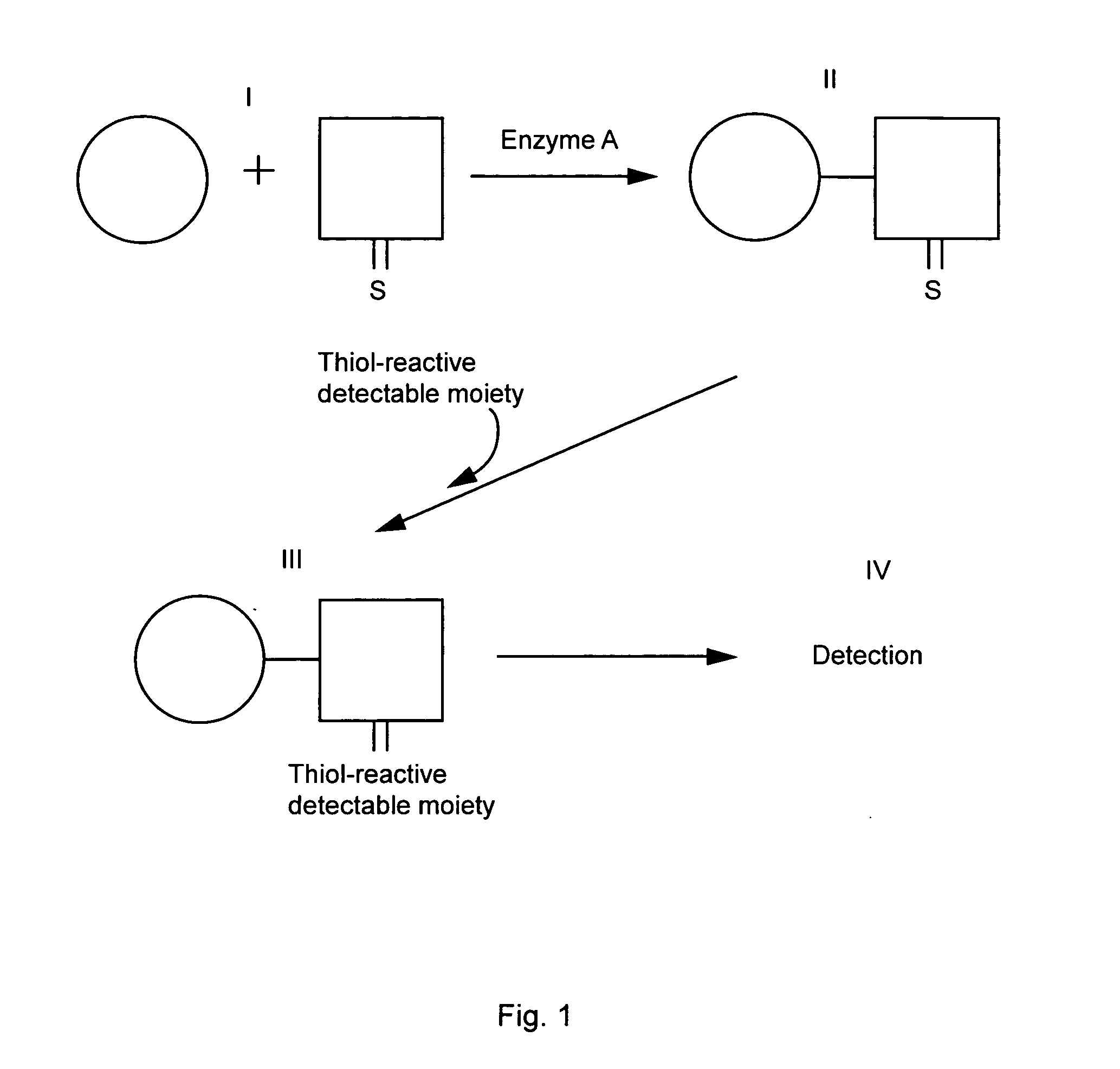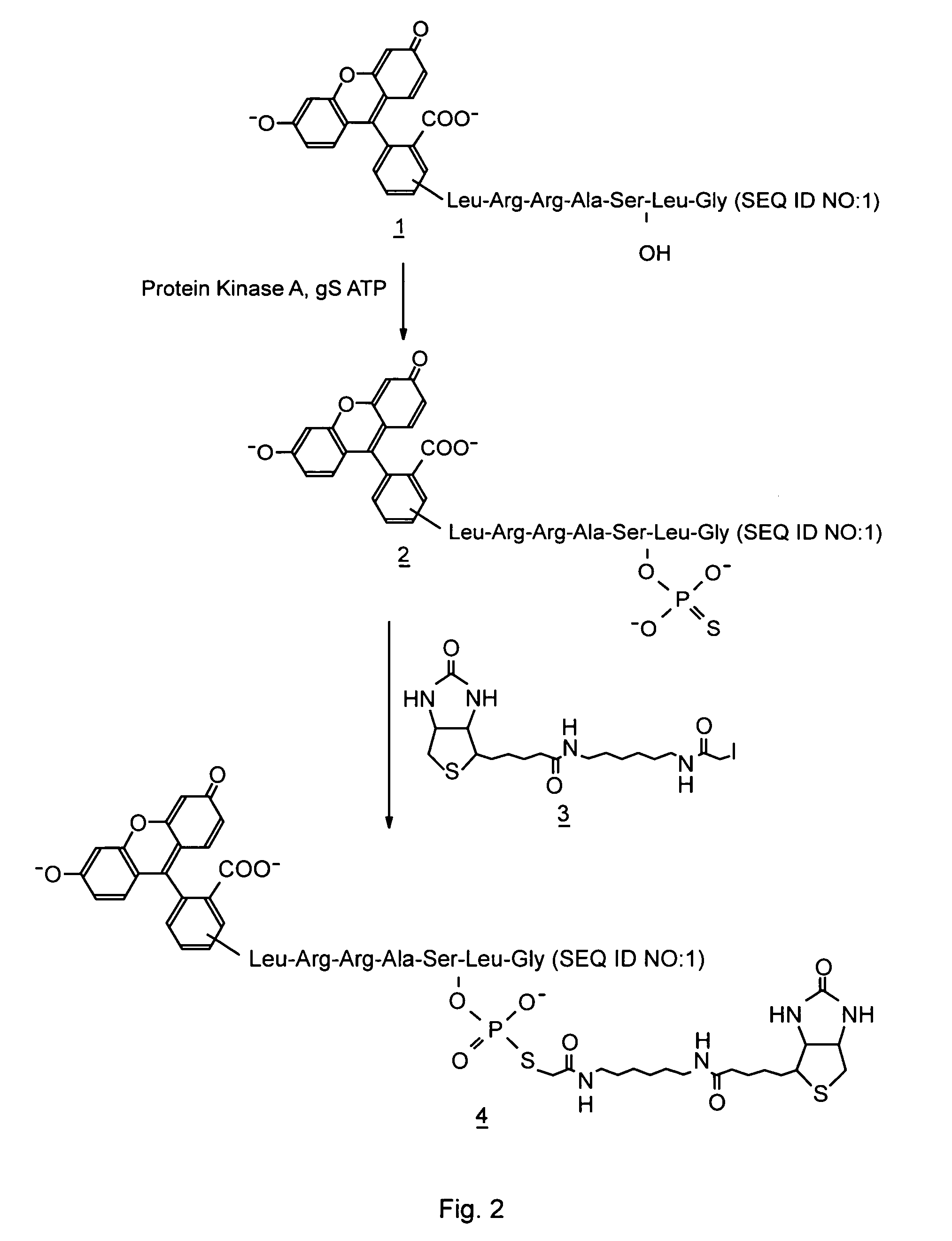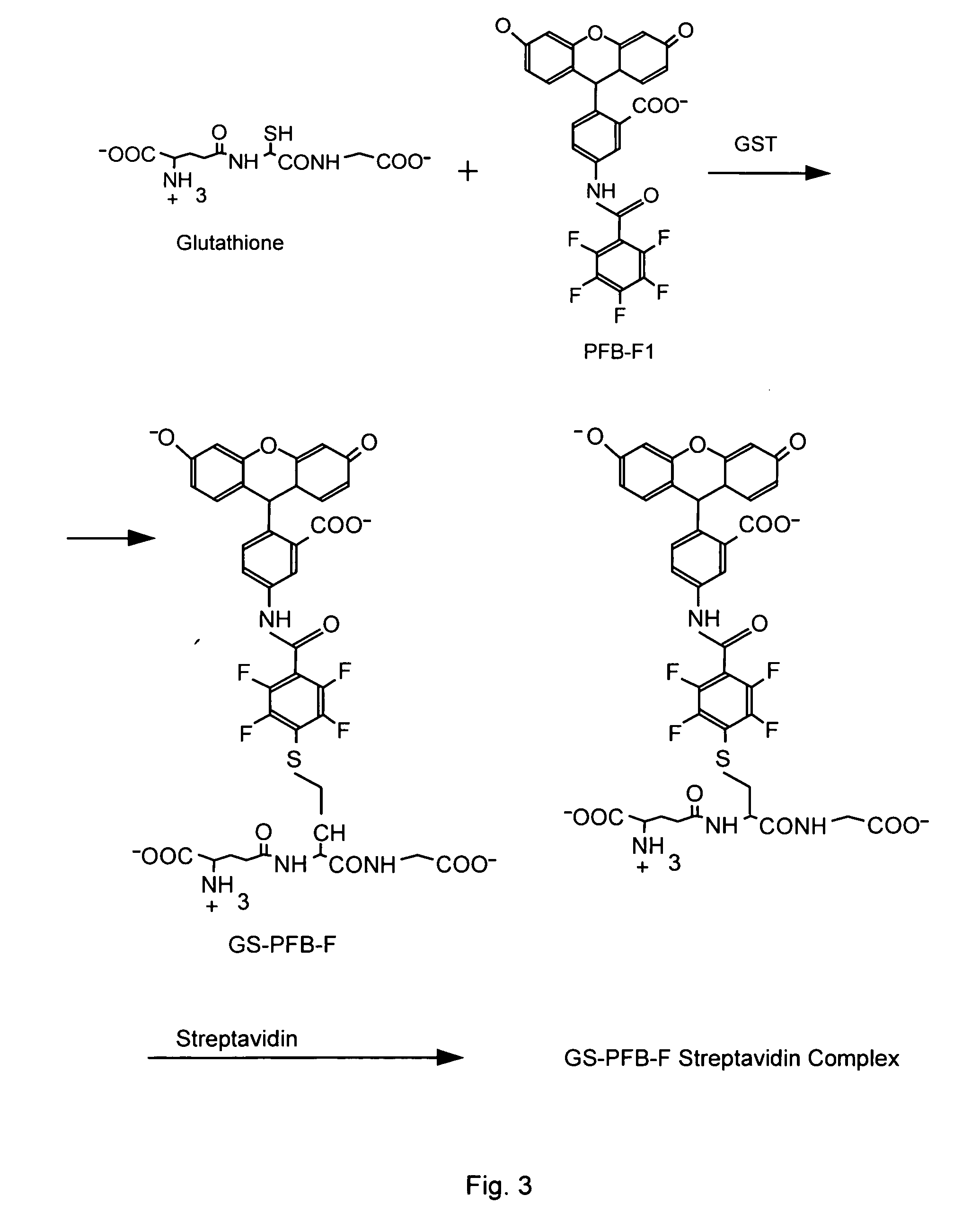Homogeneous assay methods
a technology of homogeneous assays and assays, applied in the field of homogeneous assay methods, can solve the problems of heterogeneous nature, poor suitability for high-throughput screening applications, and still has all the disadvantages of radioactive assays
- Summary
- Abstract
- Description
- Claims
- Application Information
AI Technical Summary
Problems solved by technology
Method used
Image
Examples
example 1
A Homogeneous Kinase Assay Based Upon Thiophosphorylation and Biotinylation
[0054] A. Thiophosphorylation of Kemptide
[0055] A typical reaction mixture (50 μl) contained 20 mM HEPES pH 7.5, 10 mM MgCl2, 50 μM fluorescein labeled Kemptide (Research Genetics, Huntsville, Ala., USA), 500 μM ATPyS (Sigma, St. Louis, Mo., USA, #A-1388), and 1 μl of the catalytic subunit of cAMP dependent protein kinase A (Promega Corp., Madison, Wis., USA, #V5161). The approximate final concentration of the enzyme was 700 nM. In inhibition experiments, the PKA inhibitor H-89 (Calbiochem, San Diego, Calif., USA, #371963) was added to the reaction mixture at the concentrations indicated below. The mixture was incubated at room temperature for 15 min and the reaction terminated by the addition of EDTA to 45 mM. As a negative control, EDTA was added to one of the reaction mixtures before the addition of the kinase. The extent of thiophosphorylation was then analyzed by capillary electrophoresis with fluoresc...
example 2
Determination of the Rate of Reaction of Two Thiophosphorylated Peptides with Biotin-HPDP at pH 4.2
[0067] A. Reagents: [0068] Enzymes: Protein kinase A (PKA): Promega; Aktl / PKBa: Upstate Biotechnology [0069] EZ-Link™ Biotin HPDP (Pierce) [0070] Neutravidin (a streptavidin analog) (Pierce Chemical Co.) [0071] ATPγS (Sigma, The Woodlands, Texas) [0072] Substrates (all peptides were obtained from SynPep): [0073] Aktl / PKBα: Fluorescein-Arg-Pro-Arg-Ala-Ala-Thr-Phe and [0074] BODIPY-Fluorescein-Gly-Arg-Pro-Arg-Thr-Ser-Ser-Phe-Ala-Glu-Gly
Buffers Used for the Thiophosphorylation Step:
[0075] For PKA, the reaction buffer was 10 mM HEPES, pH 7.5, 5 mM MgCl2. For Aktl / PKBα, the buffer was 10 mM HEPES, 25 mM glycerol phosphate, 5 mM MgCl2, 1 mM orthovanadate
[0076] B. Method
[0077] Following completed enzymatic thiophosphorylation, two volumes of the thiophosphorylation mixture, approx. 150 μM total thiophosphate (sum of the thiophosphorylated peptide product and residual ATPyS) were mixed w...
example 3
Fluorescence Polarization Measurements of Biotinylated Alexa 647-Labeled Peptide at pH 4.2 and 7.5
[0081] A. Reagents: [0082] Enzymes: Protein kinase A (PKA): Promega; Aktl / PKBα: Upstate Biotechnology (Waltham, Mass.) [0083] EZ-Link™ Biotin HPDP (Pierce) [0084] Neutravidin (a streptavidin analog) (Pierce) [0085] ATPγS (Sigma) [0086] Substrates (all peptides were obtained from SynPep): [0087] PKA Substrate: Alexa647-Leu-Arg-Arg-Ala-Ser-Leu-Gly
Buffers Used for the Thiophosphorylation Step:
[0088] The reaction buffer was 10 mM HEPES, pH 7.5, 5 mM MgCl2
[0089] B. Method
[0090] PKA substrate labeled with Alexa 647 (Molecular Probes) was reacted with ATPγS in the presence of protein kinase A. Following completed enzymatic thiophosphorylation, the thiophosphorylated product was biotinylated with biotin-HPDP at a pH of 4.2.
[0091] Aliquots of the reaction mixture were sampled at frequent time intervals. A portion of each aliquot was diluted to approx. 0.5 μM peptide in 50 mM HEPES buffer,...
PUM
| Property | Measurement | Unit |
|---|---|---|
| angle | aaaaa | aaaaa |
| pH | aaaaa | aaaaa |
| pH | aaaaa | aaaaa |
Abstract
Description
Claims
Application Information
 Login to View More
Login to View More - R&D
- Intellectual Property
- Life Sciences
- Materials
- Tech Scout
- Unparalleled Data Quality
- Higher Quality Content
- 60% Fewer Hallucinations
Browse by: Latest US Patents, China's latest patents, Technical Efficacy Thesaurus, Application Domain, Technology Topic, Popular Technical Reports.
© 2025 PatSnap. All rights reserved.Legal|Privacy policy|Modern Slavery Act Transparency Statement|Sitemap|About US| Contact US: help@patsnap.com



